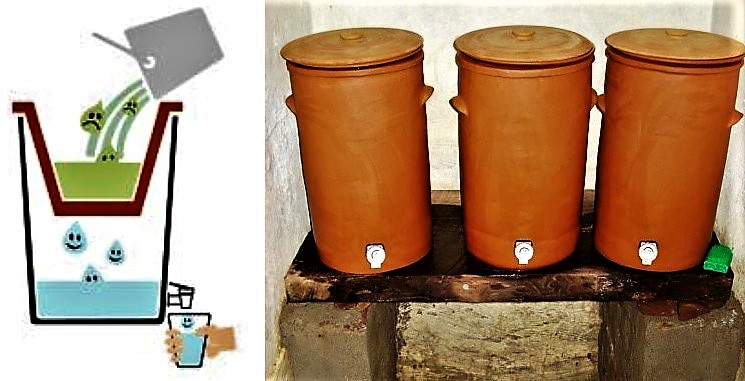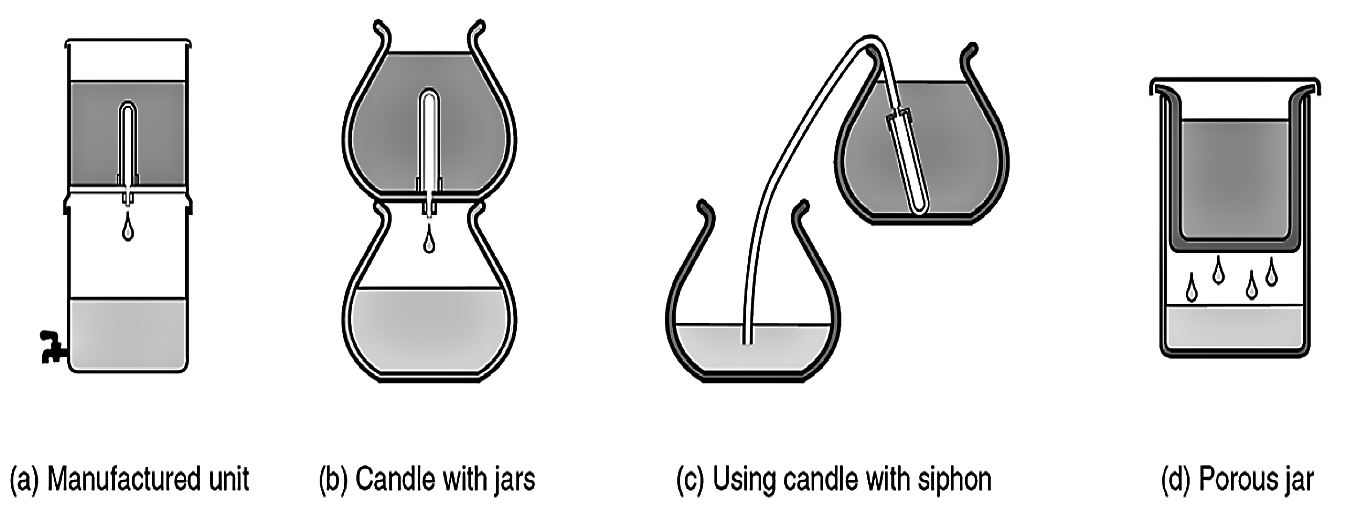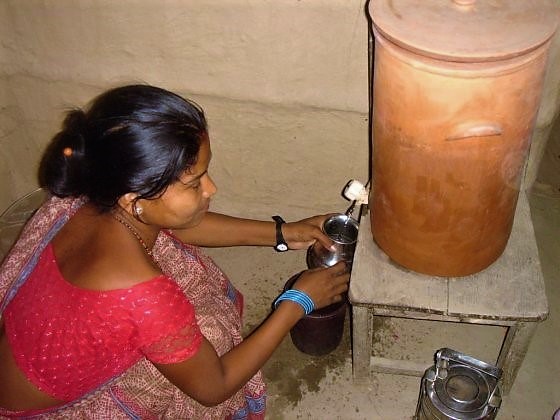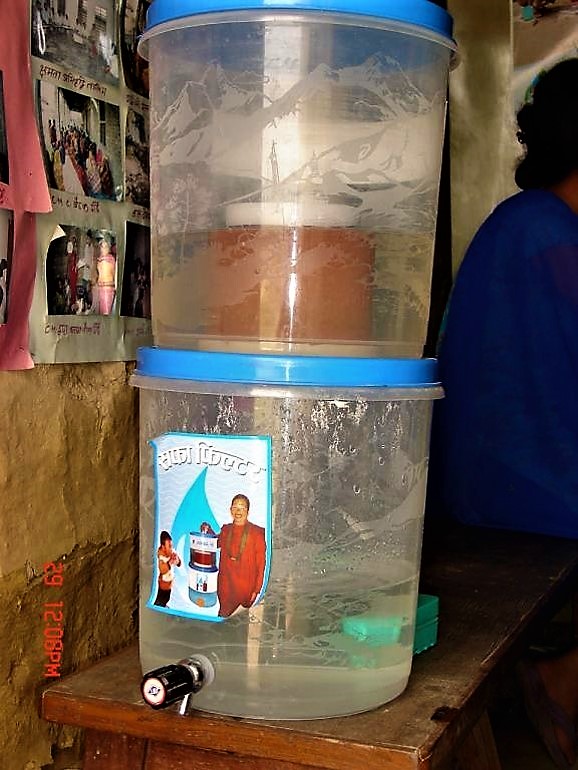Colloidal Silver Filters (CSF) are simple household water treatment devices based on a physical treatment, which does not require energy supply. CSFs use a clay candle, pot or disc made of porous ceramic materials similar to traditional ceramic filters. But in CSFs, colloidal silver is used to enhance the inactivation of bacteria and other germs. A filter set consists of two containers: the upper unit holds the ceramic coated with colloidal silver, filtering the water and killing microorganisms, while a lower unit stores the treated water. CSFs remove pathogens and turbidity from drinking water. They can be constructed with locally available material, which can contribute to the development of local commerce.
| In | Out |
|---|---|
Drinking Water |
Locally produced ceramics have been used to filter water for hundreds of years. Water is poured into a porous ceramic filter pot or in a pot containing a ceramic candle or disc, filtering the water. The filtered water is collected in another container (CAWST 2009c). The filter removes turbidity and traps and kills pathogens from drinking water (see also ceramic candle filters).
To enhance ceramic candle filters, colloidal silver can be added. Colloidal silver helps in pathogen removal and prevents the growth of microorganisms within the filter itself (CAWST 2009). These enhanced forms of ceramic filters are called colloidal silver filters (CSF). CSFs were developed at the Central American Industrial Research Institute (ICAITI) in Guatemala in 1981 and are extensively promoted today. Currently, the most widely distributed ceramic filter is the Potters for Peace (PFP) colloidal silver filter, which is shaped like a flowerpot (see also pottersforpeace.org).

The filters are designed in particular for simple household use and are a recommended household water treatment and safe storage (HWTS). They can be produced locally by attending simple technical training.
Ceramic filters consist of a set of two containers. The upper unit contains the ceramic unit, which filters the water and the lower unit collects filtered and safe water. A tab device allows the users to withdraw the water for consumption while preventing recontamination by contact with hands or other objects that could bear bacteria. The porous ceramic devices can be either one or two candles, a disc or a pot. During use, tiny silver particles (colloidal silver) are suspended in the liquid acting as a disinfectant, preventing bacterial growth in the ceramic filter and enhancing inactivation of the bacteria in the filter (LANTAGNE et al., 2006). The colloidal silver is either added to the clay mixture before firing or impregnated on the fired ceramic pot (CAWST 2009c).

Pathogens and suspended material are removed from water through physical processes such as mechanical trapping and adsorption. Colloidal silver breaks down the pathogens’ cell walls causing them to die (CAWST 2009).
The filter operation is simple. First, the filter needs to be cleaned with clean water and left aside to dry naturally. Then, the filter units need to be assembled and the upper unit should be filled with water. Then, one has to wait until the water has passed the filter fort he first time. For security, the water filtered for the first time should not be used for consumption. Then, the filter can be refilled and the now filtered water collected in the lower storage unit can is ready to drink. To prevent clogging, water with a high turbidity (levels greater than 50 NTU) should first be strained (through a cloth) or settled before using the filter CAWST 2009c).

The filter pot should be regularly cleaned using a cloth or soft brush to remove any accumulated material. It is recommended that the filter pot, candle or disc be replaced every 1-2 years (CAWST 2009c). Cleaning prevents the formation of a biofilm and protects against fine invisible cracks, which may have developed over time. Any cracks will reduce the effectiveness since water can short-circuit without being filtered through the ceramic pores (CAWST 2009c). However, make sure not to remove all the silver when using a brush for cleaning.

You can significantly reduce the size of water filters if water is used more efficiently. Read our tipps on reducing water consumption at home.
Candle filters and disc filters normally have a lower contact surface for the water and therefore the filters produce less treated water per day than pot filters. However, the effective treatment rate (or flow rate) depends on the design). A typical pot filter can produce up to 1-3 L/hour while a candle filter produces only 0.1 to 1 L/hour (CAWST 2009a; CAWST 2009c).
The effectiveness of ceramic filters at removing bacteria, viruses and protozoa depends on the pore size of the ceramic material and the production quality of the filter unit. Most ceramic filters are effective at removing the majority of the larger protozoan and bacterial organisms and helminths, but not the smaller viral organisms (CDC 2008).
Laboratory testing has shown that although the majority of the bacteria are removed mechanically through the filter’s small pores, colloidal silver is necessary to inactivate almost 100 % of the bacteria (LANTAGNE, 2001a). The effectiveness of colloidal silver on viruses is not well known but estimated to be lower due to the smaller size of virus compared or silver particles.
Turbidity (solids) is efficiently removed by physical straining (filtration) and also taste, odour and colour of filtered water by CSF is generally improved. Iron is partially removed but other dissolved chemical pollutions are not removed. The effectiveness of CSF colloidal filter has been proven in many studies, where the reduction of diarrhoeal disease incidence among users has been documented (CDC 2008; EAWAG/SANDEC 2008).
For lack of residual protection, however, it is important for users to be trained on proper operation and maintenance of the ceramic filter and receptacle (CDC 2008).
CSFs are suitable for households using turbid and contaminated water. However, ceramic filters do not remove arsenic, fluoride, pesticides or other dissolved chemicals. Due to the limited flow rate and storage capacity, CSFs are suitable for households with small families, organisations or school classes. As iron is only partially eliminated, it is recommended to use raw water with little iron only (< 0.3mg/L). Chlorinated water should not be filtered in CSFs. Due to the risk of clogging, water with a turbidity above 50 NTU should be pre-settled or strained to avoid frequent cleaning of the filter (CAWST 2009c).
Independent Appraisal of Ceramic Water Filtration Interventions in Cambodia: Final Report
Ceramic Pot Filter. Fact Sheet - Academic
Factsheet on the principles, construction, operation and maintenance of ceramic pot filters for drinking water treatment in developing countries.
CAWST (2009): Ceramic Pot Filter. Fact Sheet - Academic. (= Household Water Treatment and Safe Storage Fact Sheet - Academic ). Center for Affordable Water and Sanitation Technology (CAWST) URL [Accessed: 20.05.2019]Ceramic Candle Filter. Fact Sheet - Academic
Factsheet on the principles, construction, operation and maintenance of ceramic candle filters for drinking water treatment in developing countries.
CAWST (2009): Ceramic Candle Filter. Fact Sheet - Academic. (= Household Water Treatment and Safe Storage Fact Sheet - Academic ). Center for Affordable Water and Sanitation Technology (CAWST) URL [Accessed: 20.05.2019]Ceramic Filtration
Factsheet on the implementation of ceramic filters.
CDC (2008): Ceramic Filtration. Household Water Treatment Options in Developing Countries Factsheets. Centers for Diseases Control and Prevention (CDC) URL [Accessed: 01.04.2010]Household Water Treatment and Safe Storage (HWTS). Presentation
Presentation on the technical and non-technical aspects of sanitation household-level drinking water treatment and safe storage (HWTS) in developing countries.
EAWAG/SANDEC (2008): Household Water Treatment and Safe Storage (HWTS). Presentation. (= Sandec Training Tool 1.0, Module 3 ). Duebendorf: Swiss Federal Institute of Aquatic Science (EAWAG), Department of Water and Sanitation in Developing Countries (SANDEC) URL [Accessed: 18.02.2011]Investigation of the Potters for Peace colloidal silver impregnated ceramic filter: Report 1: Intrinsic effectiveness
This report provides investigation details on the intrinsic effectiveness of colloidal silver filters and the performance of filter with field conditions.
LANTAGNE, D.S. (2001): Investigation of the Potters for Peace colloidal silver impregnated ceramic filter: Report 1: Intrinsic effectiveness. Boston: Alethia Environmental URL [Accessed: 20.05.2019]Investigation of the Potters for Peace Colloidal Silver Impregnated Ceramic Filter Report 2: Field Investigations
Appropriate Microbial Indicator Tests for Drinking Water in Developing Countries and Assessment of Ceramic Water Filters
Efficacy of Silver-Treated Ceramic Filters for Household Water Treatment
Study on impact of the physical design (round vs. flat bottom) and silver application method (before or after firing) on the overall performance of the colloidal silver filter.
NAPOTNIK, J. MAYER, A. LANTAGNE, D. JELLISON, K. (2009): Efficacy of Silver-Treated Ceramic Filters for Household Water Treatment. Bethlehem (USA): Lehigh University, USA URL [Accessed: 20.05.2019]Sustainable Colloidal-Silver-Impregnated Ceramic Filter for Point-of-Use Water Treatment
Ceramic Water Filter Use in Takeo, Cambodia - Operational Issues and Health Promotion Recommendations
Ceramic silver impregnated pot filters for household drinking water treatment in developing countries
Ceramic Filtration
Factsheet on the implementation of ceramic filters.
CDC (2008): Ceramic Filtration. Household Water Treatment Options in Developing Countries Factsheets. Centers for Diseases Control and Prevention (CDC) URL [Accessed: 01.04.2010]Scaling Up Household Water Treatment Among Low-Income Populations
This report examines the evidence to date regarding the scalability of HWTS. It seeks to consolidate existing knowledge and experience and distil the lessons learnt. Its primary aims are to 1) review the development and evolution of leading household water treatment technologies in their efforts to achieve scale, 2) identify the main constraints that they have encountered and 3) recommend ways forward.
CLASEN, T.D. (2009): Scaling Up Household Water Treatment Among Low-Income Populations. (PhD Thesis). Geneva: World Health Organization (WHO) URL [Accessed: 09.04.2010]HWTS factsheets
Compilation of factsheets on water quality in general and description of different HWTS options such as chlorination, colloidal silver filters, biosand filter, chlorination and SODIS.
DWSS (2007): HWTS factsheets. Department of Water Supply and Sewerage (DWSS) Nepal, United States Agency for International Development (USAID), United Nations Human Settlements Programme (UN-HABITAT), United Nations Children's Fund (UNICEF)Investigation of the Potters for Peace colloidal silver impregnated ceramic filter: Report 1: Intrinsic effectiveness
This report provides investigation details on the intrinsic effectiveness of colloidal silver filters and the performance of filter with field conditions.
LANTAGNE, D.S. (2001): Investigation of the Potters for Peace colloidal silver impregnated ceramic filter: Report 1: Intrinsic effectiveness. Boston: Alethia Environmental URL [Accessed: 20.05.2019]Household Water Treatment and Safe Storage Options in Developing Countries. Review of Current Implementation Practices
Summary and brief evaluation of main household water treatment and safe storage (HWTS) options for developing countries. Options described are: chlorination, biosand filtration, ceramic filtration, solar disinfection, filtration and chlorination, flocculation and chlorination.
LANTAGNE, D. S. QUICK, R. MINTZ, E.D. (2006): Household Water Treatment and Safe Storage Options in Developing Countries. Review of Current Implementation Practices. In: ECSP (2006): Water Stories: Expanding Opportunities in small-scale Water and Sanitation Projects. Washington D.C.: 17-38. URL [Accessed: 20.05.2019]Efficacy of Silver-Treated Ceramic Filters for Household Water Treatment
Study on impact of the physical design (round vs. flat bottom) and silver application method (before or after firing) on the overall performance of the colloidal silver filter.
NAPOTNIK, J. MAYER, A. LANTAGNE, D. JELLISON, K. (2009): Efficacy of Silver-Treated Ceramic Filters for Household Water Treatment. Bethlehem (USA): Lehigh University, USA URL [Accessed: 20.05.2019]Smart Water Solutions
This booklet on water gives examples of innovations such as the use of sunlight to purify water, effective low-cost water filters, low-cost drip irrigation and locally produced hand pumps that are five times cheaper than imported pumps.
NWP (2006): Smart Water Solutions. Examples of innovative, low-cost technologies for wells, pumps, storage, irrigation and water treatment. (= Smart water solutions ). Amsterdam: Netherlands Water Partnership (NWP) URL [Accessed: 06.09.2011]Smart Disinfection Solutions
This booklet, part of the Smart Water Solutions series provides a wide range of methods and products for home water treatment in rural areas.
NWP (2010): Smart Disinfection Solutions. Examples of small-scale disinfection products for safe drinking water. (= Smart water solutions ). Amsterdam: KIT Publishers URL [Accessed: 17.05.2019]Conservation et Traitement de l Eau a Domicile
This practical guide provides a review of different processing techniques and adequate water conservation at home and is structured around 10 key questions that should be posed before choosing a suitable solution.
DESILLE, D. (2013): Conservation et Traitement de l Eau a Domicile. Paris: Programme Solidarite Eau (PSeau) URL [Accessed: 06.06.2013]Development of a Ceramic Water Filter for Nepal
Evaluation of existing ceramic water filter technologies and their performance, production processes and methods for bringing a low-cost ceramic water filter to market in Nepal.
DIES, W. (2003): Development of a Ceramic Water Filter for Nepal. Master Thesis. Cambridge (USA): Massachusetts Institute of Technology URL [Accessed: 06.04.2010]FILTRON. Ceramic Filters for Drinking Water
Case study from Nicaragua on the dissemination of locally constructed enhanced ceramic filters (colloidal silver filters)
IDEASS (n.y): FILTRON. Ceramic Filters for Drinking Water. United Nations Development Programme (UNDP), United Nations Office for Project Services (UNOPS) and ILO/Universitas URL [Accessed: 20.05.2019]Ceramic Candle Filter. Fact Sheet - Academic
Factsheet on the principles, construction, operation and maintenance of ceramic candle filters for drinking water treatment in developing countries.
CAWST (2009): Ceramic Candle Filter. Fact Sheet - Academic. (= Household Water Treatment and Safe Storage Fact Sheet - Academic ). Center for Affordable Water and Sanitation Technology (CAWST) URL [Accessed: 20.05.2019]Ceramic Candle Filter. Fact Sheet - Simplified
Simplified factsheet on the principles, construction, operation and maintenance of ceramic candle filters for drinking water treatment in developing countries
CAWST (2009): Ceramic Candle Filter. Fact Sheet - Simplified. (= Household Water Treatment and Safe Storage Fact Sheet - Simplified ). Center for Affordable Water and Sanitation Technology (CAWST) URL [Accessed: 20.05.2019]Ceramic Pot Filter. Fact Sheet - Simplified
Simplified factsheet on the principles, construction, operation and maintenance of ceramic pot filters for drinking water treatment ion developing countries.
CAWST (2009): Ceramic Pot Filter. Fact Sheet - Simplified. (= Household Water Treatment and Safe Storage Fact Sheet - Simplified ). Center for Affordable Water and Sanitation Technology (CAWST) URL [Accessed: 20.05.2019]Ceramic Pot Filter. Fact Sheet - Academic
Factsheet on the principles, construction, operation and maintenance of ceramic pot filters for drinking water treatment in developing countries.
CAWST (2009): Ceramic Pot Filter. Fact Sheet - Academic. (= Household Water Treatment and Safe Storage Fact Sheet - Academic ). Center for Affordable Water and Sanitation Technology (CAWST) URL [Accessed: 20.05.2019]HWTS training guideline
This training manual provides information on various household drinking water treatment options. Each description contains an introduction to the technology, its working mechanism, costs, advantages and limitations (Nepali).
DWSS (2008): HWTS training guideline. Nepal: Department of Water Supply and Sewerage (DWSS)Household Water Treatment and Safe Storage (HWTS). Lecture Notes
Lecture notes on the technical and non-technical aspects of sanitation household-level drinking water treatment and safe storage (HWTS) in developing countries.
EAWAG/SANDEC (2008): Household Water Treatment and Safe Storage (HWTS). Lecture Notes. (= Sandec Training Tool 1.0, Module 3 ). Duebendorf: Swiss Federal Institute of Aquatic Science (EAWAG), Department of Water and Sanitation in Developing Countries (SANDEC) URL [Accessed: 08.04.2010]Household Water Treatment and Safe Storage (HWTS). Presentation
Presentation on the technical and non-technical aspects of sanitation household-level drinking water treatment and safe storage (HWTS) in developing countries.
EAWAG/SANDEC (2008): Household Water Treatment and Safe Storage (HWTS). Presentation. (= Sandec Training Tool 1.0, Module 3 ). Duebendorf: Swiss Federal Institute of Aquatic Science (EAWAG), Department of Water and Sanitation in Developing Countries (SANDEC) URL [Accessed: 18.02.2011]Preventing Diarrhoeal Disease in Developing Countries: Proven Household Water Treatment Options
One-page introduction to main household water treatments methods, and further reading links.
CDC/USAID (2008): Preventing Diarrhoeal Disease in Developing Countries: Proven Household Water Treatment Options. Atlanta and New York: Center for Disease Control and Prevention (CDC) and United States Agency for International Development (USAID) URL [Accessed: 15.03.2010]Flip Chart on HWTS
Amoeba and Water
This children’s book provides information on safe drinking water, ways of water contamination, simple HWTS options presented in attractive illustrations and simple languages so that school children can easily understand them.
ENPHO (2007): Amoeba and Water. Kathmandu and New York: Environment and Public Health Organization (ENPHO) and United Nations Children's Fund (UNICEF) URL [Accessed: 19.05.2019]Potters for Peace
Website of Potters for Peace, containing a large amount of information on the implementation and other practical aspects concerning the application of colloidal silver filters for drinking water treatment in Central America. Potters for Peace is a US non-profit organisation, which promotes the local production of ceramic filters as a small business.
Colloidal silver impregnated ceramic filter in Yemen
Video showing the production process of colloidal silver filter in Yemen.
Resource Development International – Cambodia (RDI)
Resource Development International (RDI) has implemented various projects designed to provide clean water to rural villagers of Cambodia. This page briefly describes some of the explored technical solutions, including ceramic filtration, rainwater harvesting, arsenic testing, pumps and some latrines.

